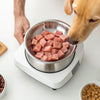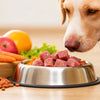What’s a Raw Dog Food Diet? Understanding the Benefits, Risks, and Best Practices
- Houndsy
Table of Contents
- Introduction
- What is a Raw Dog Food Diet?
- The Benefits of a Raw Dog Food Diet
- The Risks of a Raw Dog Food Diet
- How to Transition Your Dog to a Raw Food Diet
- Should I Feed Half Kibble and Half Raw?
- Conclusion
Introduction
Did you know that around 39% of dog owners have considered switching to a raw dog food diet for their furry companions? The growing interest in this dietary approach signifies a search for healthier, more natural options in pet care. As devoted dog owners, we often evaluate what goes into our pets' bowls, striving for a balance between health, energy, and enjoyment. But what's a raw dog food diet really all about, and how can it affect our pets' well-being?
In this blog post, we’ll explore the concept of a raw dog food diet, commonly referred to as the BARF (Biologically Appropriate Raw Food) diet, and its rising popularity among pet lovers. We’ll delve into what constitutes a balanced raw diet, examine its potential advantages and drawbacks, and provide guidance on transitioning your pup to a raw feeding regimen. By the end, you’ll have a well-rounded understanding of whether a raw dog food diet aligns with your pet’s nutritional needs.
Let’s embark together on this journey of discovery, reflecting on our own pet feeding routines and how they might benefit from innovative approaches aligned with Houndsy’s mission to simplify and elevate pet care.
What is a Raw Dog Food Diet?
The core idea behind a raw dog food diet is to emulate what dogs would naturally consume in the wild. This approach typically consists of raw meat, bones, organ meats, vegetables, and occasionally fruits. Originating from the work of Australian veterinarian Dr. Ian Billinghurst in the 1990s, the BARF diet aims to provide dogs with a wholesome and biologically appropriate nutritional profile, similar to their ancestors.
Key Components of a Raw Diet
A typical raw dog food diet includes several key components, each playing a vital role in ensuring that your furry friend receives a balanced diet. Here’s a breakdown of those components:
-
Muscle Meat: This constitutes the main source of protein. Cuts like chicken breast, beef steak, and lamb chop are popular choices, providing essential amino acids necessary for optimal health.
-
Raw Edible Bones: Soft, raw bones can serve as an excellent source of calcium and phosphorous. They also support dental health through chewing.
-
Organ Meats: Packed with vital nutrients, organ meats like liver and kidney are crucial. They contain vitamins A, D, and B12, as well as essential fatty acids that keep your dog's coat healthy.
-
Vegetables: While dogs are primarily carnivorous, including dog-safe veggies like spinach, carrot, and broccoli can aid digestion and provide fiber, vitamins, and minerals.
-
Fruits: Certain fruits like apples and blueberries can act as a treat or supplement, offering antioxidants and incorporating variety into your dog’s meals.
-
Supplements: Depending on your dietary formulation, you may need to add supplements like fish oil for Omega-3 fatty acids or kelp to ensure a balanced intake of nutrients.
The Prey Model vs. BARF Diet
Within the raw food community, two common approaches exist: the Biologically Appropriate Raw Food (BARF) method and the Prey Model Raw (PMR) diet. The BARF diet allows for the inclusion of vegetables and fruits alongside raw meats, while the PMR focuses strictly on animal-based ingredients, closely resembling a wild wolf's diet—predominantly muscle and organ meats with some bones.
A Balanced Approach
Achieving a balanced raw diet involves careful attention to ingredient ratios. For instance, a typical BARF diet may consist of:
- 70% Muscle Meat
- 10% Raw Edible Bones
- 10% Organs (at least half being liver)
- 10% Fruits and Vegetables
Is a Raw Dog Food Diet Right for Your Pet?
Considering switching your dog to a raw diet? Reflect on several factors first:
-
Health Condition: Healthy adult dogs may thrive on a raw diet, but pups, seniors, or dogs with specific health conditions (like kidney disease) should consult their veterinarian before making dietary changes.
-
Activity Level: Active and athletic breeds often benefit from higher protein intake provided by raw foods, while less active dogs may not require such a protein-heavy diet.
-
Food Preferences: It’s essential to recognize your dog's unique tastes and textures. Some pets may take time to adapt to the new diet.
The Benefits of a Raw Dog Food Diet
Research and anecdotes from pet owners indicate various benefits associated with raw dog food diets. While individual results may vary, let's explore some common advantages noted by proponents of this feeding approach.
1. Shinier Coats and Healthier Skin
Raw diets rich in essential fatty acids—like Omega-3—can yield a noticeable change in your dog’s coat and skin health. Improved nutrition can help eliminate dryness and enhance shine, illustrating some visible benefits.
2. Stronger Teeth and Fresher Breath
The act of chewing raw bones can bolster dental health by naturally scraping off plaque and tartar. This aspect can also lead to fresher breath, reducing the need for dental cleanings or treatments.
3. Better Digestion and Smaller Stools
Many dog owners report observing less volume in their pet's stools after switching to a raw diet. This can result from more efficient digestion of raw foods, as they typically contain fewer fillers and carbohydrates compared to commercial kibble.
4. Increased Energy Levels and Vitality
A diet closer to what dogs are biologically designed to eat can lead to heightened energy levels and an overall sense of vitality. Many pet owners notice increased enthusiasm on walks and during playtime.
5. Personalized Nutritional Control
Making your own dog food allows you to dictate exactly what your dog consumes. This customization enables you to adjust based on your dog's age, health, and dietary preferences.
6. Reduced Need for Vet Visits
Some proponents argue that the benefits of improved health and vitality can lead to fewer trips to the vet, primarily if the changes in the diet reduce common health issues like obesity, skin irritation, or dental problems.
The Risks of a Raw Dog Food Diet
While the benefits are compelling, it's equally essential to consider the potential risks and challenges associated with raw feeding. As with any pet dietary choice, the key is to make informed decisions.
1. Bacterial Contamination
Raw meat can harbor harmful bacteria like Salmonella and E. coli. If not handled properly, these pathogens can pose a risk to both pets and humans. It’s crucial to practice good hygiene by washing hands, utensils, bowls, and surfaces thoroughly after handling raw meat.
2. Nutritional Imbalance
Creating a balanced raw diet can be complex and requires precise knowledge of your dog’s nutritional needs. Incomplete or improperly proportioned diets can lead to deficiencies or excessive intake of certain nutrients over time.
3. Bone Safety
While bones can be beneficial, they also pose risks. Hard bones can lead to broken teeth, while small pieces may cause choking if not monitored. It’s important to supervise your dog while they enjoy their raw bones and avoid giving cooked or processed bones entirely.
4. Parasites and Food Safety
Unfrozen or improperly sourced meat can contain parasites. To mitigate risks, always use high-quality, reputable sources for raw meat. Freezing meat before feeding can help kill off some parasites.
5. Cost Considerations
Feeding a raw diet can be more expensive than kibble, especially if you opt for high-quality ingredients. Evaluating your budget for pet care is important when considering a switch.
How to Transition Your Dog to a Raw Food Diet
Transitioning your dog to a raw diet requires patience and careful planning. Here are some tips to ensure a smooth switch:
Start Slow
Begin by incorporating raw food gradually. A good method is to mix a small portion of raw food with your dog's current diet, progressively increasing the raw amount while decreasing their previous food.
Monitor for Changes
Keep a close eye on your dog's reaction to the new diet. Changes in stool consistency, energy levels, and overall behavior will help you gauge how well they are adjusting.
Variety Is Key
Once your dog adapts to raw food, introduce a variety of proteins over time. This could include chicken, beef, lamb, and fish. Providing diverse meats ensures they receive a wide range of nutrients.
Consult Your Vet
Prior to making significant dietary changes, it’s advisable to consult with a veterinarian who understands the nuances of raw feeding. This support can be invaluable in creating an optimal diet plan tailored to your dog's needs.
Should I Feed Half Kibble and Half Raw?
Mixing kibble and raw food can provide the excitement of a varied diet while incorporating the benefits of both worlds. This approach allows pet owners to supplement specialized kibble with high-quality raw ingredients, helping to balance cost and health.
Is this a Good Compromise?
Many owners find success with this hybrid approach, achieving an optimal blend of convenience and nutritional variety. Ensuring that your kibble is high-quality and nutritionally balanced further supports this mixed feeding strategy.
Conclusion
In exploring the question of what's a raw dog food diet, we've traveled through its historical context, nutritional advantages, and potential risks. Our understanding of canine dietary needs has grown alongside the shifting landscape of pet care, emphasizing the importance of nutrition for our cherished companions.
Ultimately, whether you choose to embrace a raw diet, revert to kibble, or find your perfect blend, the most crucial consideration is your pet's health and happiness. As this choice increasingly becomes part of a modern feeding ritual, we at Houndsy invite you to explore the art of dog feeding further. Consider our flagship product, the Houndsy Kibble Dispenser, designed to enhance the feeding experience with convenience and style. Learn more about the Houndsy Kibble Dispenser here..
FAQs
1. Is a raw dog food diet safe for all dogs?
Not all dogs are suited for a raw diet, particularly those with health issues, puppies, and senior dogs. Always consult your veterinarian before transitioning.
2. How do I balance a raw dog food diet?
A balanced raw diet typically includes specified portions of muscle meat, organ meats, raw bones, and vegetables/fruits. Following established guidelines or consulting a pet nutritionist can help.
3. Can I make my own raw dog food, or should I buy commercial?
Homemade raw diets offer control but require knowledge of nutrition. Commercially prepared raw diets take care of this balance, ensuring convenience and safety.
4. What should I watch for when transitioning my dog to a raw diet?
Monitor your dog's stool, energy levels, and physical condition during the transition. Adjust accordingly based on their response.
5. How can I store raw dog food safely?
Store raw dog food in the freezer before use, and keep thawed portions refrigerated, using them within a few days for optimal safety and quality.
Now, are you ready to embark on this feeding journey for your furry friend? Let’s refine that bowl and bring innovation into pet care together with Houndsy!












